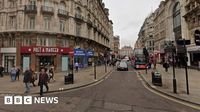Central London’s busy streets were thrown into chaos on Tuesday afternoon, October 28, 2025, when a 57-year-old man was struck by a piece of falling masonry at the bustling junction of Coventry Street and Whitcomb Street, just off Leicester Square. The incident, which unfolded outside the Pret a Manger on the corner, left bystanders in shock and prompted an immediate and robust emergency response.
According to reports from BBC and LBC, the man was walking along the pavement when a cast iron decorative ball, believed to have been part of the building’s ornate facade, plummeted from above. The impact was severe, hitting the pedestrian on the head and causing what one eyewitness described as a “widely open head wound with a lot of blood.” The scene quickly descended into panic as horrified onlookers heard “horrific screaming and everyone started running away,” as another witness recalled to BBC.
Emergency services were called to the scene at approximately 2:27 pm, as confirmed by the London Ambulance Service. Their swift response included ambulance crews, an incident response officer, an advanced paramedic practitioner, and London’s Air Ambulance. The man received immediate treatment on the pavement outside the popular sandwich shop, with medics working quickly to stabilize him before he was airlifted to a major trauma centre in London. At the time of reporting, the full extent of his injuries remained unclear.
Police quickly cordoned off the area, urging members of the public to avoid the junction of Coventry Street and Whitcomb Street while the incident was ongoing. “Emergency services are responding to an incident in Coventry Street, W1 after reports a piece of masonry fell from a building and hit a 57-year-old man,” a Metropolitan Police spokesperson told LBC. “The man is currently receiving treatment from the London Ambulance Service and will be taken to hospital shortly by London’s Air Ambulance. The severity of his injuries are not known at this stage. This incident is ongoing. People are advised to avoid the area at this time.”
For those familiar with Leicester Square, the location is no stranger to heavy foot traffic, especially as it sits at the heart of London’s entertainment district. The area is lined with shops, theatres, restaurants, and draws tourists and locals alike throughout the day. The suddenness of the incident, in such a public and busy location, only heightened the sense of alarm. “I saw someone with blood everywhere, they had been hit by something,” an eyewitness recounted to BBC. “It looked as though work was going on at the building.”
Indeed, several accounts confirmed that construction or maintenance work appeared to be underway on the building from which the masonry fell. One witness told LBC that the cast iron decorative ball “fell from upstairs,” suggesting that the upper levels of the building were the source of the debris. The precise cause of the accident, and whether it was directly related to ongoing work, is still under investigation by authorities at the time of writing.
This incident has reignited concerns about the safety of London’s historic buildings, many of which feature elaborate facades and decorative elements that, while beautiful, can become hazardous if not properly maintained. The city’s dense urban environment, combined with the age of many structures, means that even routine maintenance can carry risks. In recent years, London has seen several incidents involving falling masonry, though few have resulted in such dramatic and public consequences.
London Ambulance Service provided a detailed account of their response: “We were called today (Tues 28) at 2.27pm to reports of a person injured in Coventry Street, London, W1. We sent resources to the scene including ambulance crews, an incident response officer, an advanced paramedic practitioner and London’s air ambulance. We treated a man at the scene before taking him to a London major trauma centre.” Their rapid deployment was credited with providing critical care to the victim in those vital first moments after the accident.
In the aftermath, police maintained a visible presence at the scene, both to investigate the circumstances of the accident and to ensure public safety. The area around the junction remained cordoned off for several hours, leading to significant disruption for local businesses and pedestrians. Authorities emphasized the need for caution and patience as they worked to secure the site and determine the root cause of the incident.
While the identity of the injured man has not been released, the incident has prompted an outpouring of concern from the local community and from those who witnessed the event. Many took to social media to express their shock and to praise the emergency services for their swift and professional response. The sense of vulnerability was palpable, with many Londoners reflecting on how such a freak accident could happen to anyone, in a place so familiar and seemingly safe.
The building involved, like many in the area, is an example of Victorian or Edwardian architecture, characterized by ornate stonework and decorative features. While these contribute to the city’s charm and heritage, they also pose ongoing challenges for maintenance and safety. Regulations require regular inspections and upkeep, but incidents like this serve as a stark reminder of the potential dangers when even a small lapse occurs.
At the time of reporting, investigators were still working to establish whether the falling masonry was a direct result of construction activities, weathering, or another factor. The Health and Safety Executive, which oversees workplace and public safety in the UK, is expected to conduct a thorough review of both the building’s condition and the procedures followed by any contractors or workers present at the time.
For now, the focus remains on the recovery of the injured man and on ensuring the safety of the area for the thousands who pass through Leicester Square every day. Police and emergency services continue to monitor the scene, and local authorities have pledged to review safety protocols for similar buildings in the vicinity.
As Londoners go about their daily routines, the incident serves as a sobering reminder of the unpredictable hazards that can arise in even the most familiar settings. For those who witnessed the event, the memory of that afternoon—of the chaos, the screams, and the swift response of the city’s emergency teams—will linger long after the cordons are lifted and the streets return to normal.
With investigations ongoing and the area gradually reopening, attention now turns to broader questions about building safety and the responsibilities of those tasked with maintaining London’s architectural legacy. For one man and his family, however, the day’s events have left a far more personal mark, and the city waits anxiously for news of his recovery.




